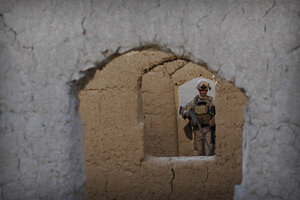Marines prep for key Taliban offensive in southern Afghanistan
Marines will launch a major offensive against the Taliban in Afghanistan's district of Marjeh. It could be similar to the battles of Fallujah in Iraq in 2004.

A US Marine searches a building during an operation in the Garmsir district of the volatile Helmand province, southern Afghanistan, Thursday.
Kevin Frayer/AP
Nawa, Afghanistan
Brig. Gen. Larry Nicholson is prepping his Marines to launch a major offensive against the Taliban in southern Afghanistan – in what could be a game-changer in the operations here.
Nicholson, the senior Marine commander in Afghanistan, will in the coming weeks receive hundreds of reinforcements, the first wave of forces to deploy as part of President Obama’s surge. That will allow Nicholson to pierce the Taliban stronghold of Marjeh – a 100-square-mile region that must, in the words of another senior Marine officer, be “cracked open.”
The Taliban has been operating in the district of Marjeh since being pushed out of other areas of Helmand Province. There are reportedly opium stockpiles in Marjeh.
“We’re going to go in big,” Nicholson said with panache Thursday, standing on a remote base in Nawa with Marines, Afghan officials, and a gaggle of reporters around him. “We’re going to put the enemy on the horns of a dilemma – again,” he says.
Nicholson’s rhetorical swagger may be nothing more than posturing. But he has reason to be confident, pointing to other areas in Helmand where the population, forced to choose sides, has gone against the Taliban.
One of those areas is the village of Nawa. On Thursday, Nicholson escorted Adm. Mike Mullen, chairman of the Joint Chiefs of Staff, on a walk through Nawa's market to demonstrate how quickly things can change. Just five months ago, this area was under daily attack, and Afghans didn’t frequent the market.
Wearing no body armor, Nicholson took Mullen through a rough opening in a cement wall to a thriving marketplace. Dozens of shops sell everything from produce to plastic pails. Children jockey for the colored pencils that the marines hand out and try to snooker passersby into giving away their sunglasses.
There's a weekly livestock bazaar, and development officials even have plans to build a stage for poetry readings.
Measuring success can be difficult in a counterinsurgency, where “winning” can be far more nuanced. But Nicholson points to the families who are returning to the area as proof that the clear-hold-and-build strategy is working.
In defending Mr. Obama’s strategy here, American officials have pointed out that the mission was chronically underresourced. Now, with the infusion of more troops, such operations have a greater likelihood of success.
Nicholson’s plans for Marjeh call to mind the battles of Fallujah in Iraq in 2004. Those block-by-block street fights left many dead or wounded, but they ultimately sent a strong message to Sunni insurgents. Many military officials expect casualties to mount in the opening salvo of the strategy in Marjeh. But the operation may not be nearly as “kinetic” (a big battle characterized by combat operations), says Nicholson, unless it has to be. And it will cover a much wider area.
He is mum on the details, saying only that going in with more forces is better than going in with too few. Both military experts and independent analysts expect that the Taliban, cornered, may fight harder than in other areas of Helmand, where the Marines have met relatively light resistance.
Mullen, on a week-long tour of the region, has been selling Obama’s war plans to the troops here. “I’m proud of you. You’ve made a big difference, and you’ll continue to do that,” he told the Marines at Nawa. “A lot of us are continuing to count on the work you are doing.”
-----
Follow us on Twitter.
